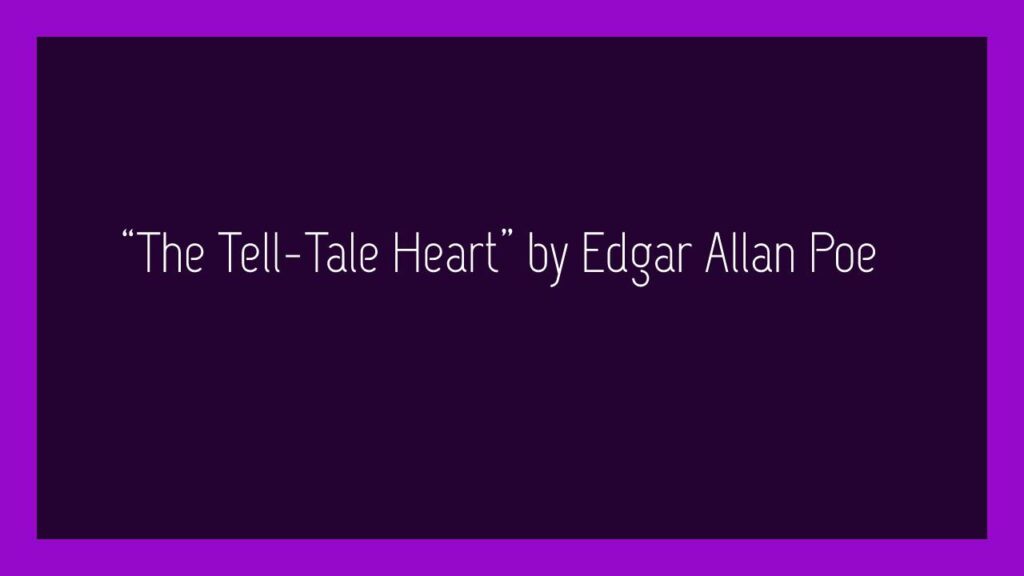Symbolism in Edgar Allan Poe’s The Tell-Tale Heart

Edgar Allan Poe is a creator of many works of art, particularly in the tales of secrets. One of his most well known works is “The Tell-Tale Heart,” a secret story that is viewed as one of the exemplary works of a Gothic class. With the exception of puzzling and enigmatic plot, the way how Edgar Allan Poe developed a portrayal style genuinely deserve evaluation.
It is additionally accepted that symbolism in “The Tell-Tale Heart” merits a lot of consideration, particularly after re-perusing this brief tale. How about we figure out how symbols in Edgar Allan Poe’s “The Tell-Tale Heart” pass faculties and implications beforehand inaccessible on to comprehend. Peruse on.
Allow us momentarily to help you to remember the primary components of The Tell-Tale Heart plot, which may be pertinent for grasping the power of symbolism. This puzzling writing is told from the first-individual story of an anonymous narrator who feels that an elderly person, a narrator neighbor, and his vulture eye is liable for his trouble. Thusly, that’s what a narrator understands in the event that the wrongdoing is arranged and executed in cautious accuracy, his mental soundness will end once and until the end of time.
After cautiously arranging his activities of focusing a bit of light onto an elderly person’s eye for seven evenings, on the eighth evening, a heartbreaking occasion at last happens. In the wake of hearing an elderly person’s heartbeat, a narrator opens the lamp, in the end covering an elderly person in his room. The murder is followed by dismantling his body parts and covering them under the planks of flooring of the loft.
During a murder, an elderly person’s shouting was a detailed shouting heard by a neighbor to the police. During police visit, a narrator calls the police that he is blameless by showing that the shout heard was of his own. A heartbreaking element is that an entire discussion occurred on where the remaining parts were covered up.
The story closes with a narrator’s trouble, who feels awkward with commotions, which were accepted to be an elderly person’s heart thumping. Despite the fact that main a narrator heard these commotions, however not the cops, a narrator in the long run separates and admits about his wrongdoings.
With such powerful composition, symbolism can be found for all intents and purposes anyplace, going from a lamp and a room to the heart and an eye.
Primary symbols of the story
In most writing concentrate on guides, it is normal to concur that both an eye and the heart are objects that be the primary symbols of a story. As far as an eye, it is constantly depicted in this story as a “vulture” one, which is a bird that feeds on one’s dead tissue. This image alludes to death and going after another, while its blue range tone additionally addresses briskness in the aims to kill the elderly person. In The Tell Tale Heart, an eye addresses an item that watches a narrator constantly, ultimately turning into its principal inspiration to kill. Some review directs likewise point out that an eye is additionally an image of insight, really intending that notwithstanding a narrator performing malicious undertakings, an inspiration of such activities actually stays unsure.
With the exception of an eye, which assumes a focal part, the heart addresses all repulsions of murder more dynamically. Any review guide will concur that while an eye in a real sense controls a narrator, those heart pulsates address that all wrongdoings can torment individuals. The wellspring of those commotions was muddled, with most review guides guaranteeing that those sounds were of a narrator’s own body. In any case, the symbolism of tormenting that can arise even after one is gone for good is major areas of strength for a that must be referenced.
Another image that must be remembered for a review guide alludes to a house. By tolerating responsibility in the moment hand that he is liable for the passing of an elderly person, a narrator emblematically attempts to conceal a wrongdoing in his psyche. The equivalent goes for concealing dissected stays of an elderly person underneath the sections of flooring. A whole crime location emblematically addresses an endeavor to conceal the psyche. Since every one of the inner mind acts generally return, a somewhat late confession should be visible as a spilled truth.
Beneficial mentionings
Despite the fact that the major representative items are referenced over, a couple of minor references merit consideration because of their significance for figuring out this story. In any review guide, it is normal to say that passing watches that draw in mates are references to beatles who bang their heads. This component alludes to a far reaching conviction that these bangs address a commencement to somebody’s death.
One more component in Edgar Allan Poe’s “The Tell-Tale Heart” that represents a division is a room itself. At the point when a narrator hears that an elderly person awakened during the last evening of his life, a room addresses an individual’s weakness. In our review guide, we find it pertinent to make reference to that bed likewise addresses an overall security of an individual dozing. Thus, as per the narrator’s point of view, the bed is the murder weapon that can transform an individual into a dead state, in the long run bringing out a feeling that it can turn into an entombment place.
Last comments
With various symbols all through this story, The Tell-Tale Heart concentrate on guide is a good opportunity to investigate all references made by Poe. While a narrator acknowledges his culpability and admits toward the finish of this story, these symbols permit understanding inspirations and minor references made by the creator. Such an examination permits following what Poe implied by depicting a puzzling and enigmatic story of a Gothic murder with a follow-up confession.
